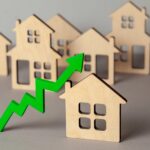The National Association of Home Builders, or NAHB, periodically conducts surveys to collect information from national home builders about construction costs and the elements that go into the price of single-family new construction. The last NAHB construction cost survey, taken in 2019, reflects essential information that the home building industry often considers when looking at historical home building price data.
How is the Survey Conducted?
The most recent survey conducted by NAHB in 2019 emailed their questionnaire to a sampling of approximately 6,516 new home builders throughout the United States. The samplings were based on the previous year’s single-family starts and the four principal Census regions of the country.
A subcategory was implemented for each of the eight major building steps of a home, further broken down into 35 sections under each appropriate construction stage. Each respondent was asked to submit information based on homes built by their companies in 2019. From those surveys sent, 49 builders returned usable responses.
Home and Lot Sizes
In 2019, the average size of a single-family new build was 2,594 square feet of finished floor space. This represents the smallest square footage since 2011. The average home in 2009 was 2,716 sq. ft. but dropped to 2,311 sq. ft. in 2011 as the demand for homes eroded after the recession. It peaked again in 2015 but has trended downward since then. This parallels Census information and suggests that builders are shifting to more affordable housing.
In 2019, the average lot size reported by respondents was 22,094 square feet or roughly a half-acre. This represents the largest average lot size in the survey’s history. But this figure deviates from overall Census data. Lot sizes have fluctuated significantly over the years with the largest lot sizes showing in 2009, 2011, and 2015 and the smallest in 2018.
Sales Prices
In 2019, the average single-family home sales price was $485,128. This represents the highest average sales price in the survey’s history. Census data has shown that single-family home prices increased steadily after the recession, from $267,900 in 2011 to $385,000 in 2018 but prices accelerated in 2019 due to record low mortgage rates and an expanded labor market.
Price Breakdowns
The NAHB survey asked its respondents to break down the costs of building their homes into seven categories, including
- The cost of the finished lot
- The total cost of construction
- The financing cost
- The cost of their overhead and general expenses
- The cost of marketing
- Costs of sales commission
- Builder profit before taxes
The 2019 survey indicates that, on average, 61.1 percent of the final cost of a new construction single-family home was attributable to the total cost of construction, 18.5 percent to the finished lot, 4.9 percent to overhead and general expenses, 3.7 percent to commissions, 1.7 percent to financing, and 1.0 percent to marketing. This left 9.1 percent in pre-tax profit.
A Breakdown of Construction Costs
The 2019 survey showed that the construction cost of the average single-family home was $296,652, or about $114 per square foot. This compares to $80 per square foot in 2011, $95 per square foot in 2013, $103 per square foot in 2015, and $86 per square foot in 2017.
The eight stages of construction broken down by cost percentages include
- Interior finishes – 25.4%
- Framing – 17.4%
- Major system rough-in – 14.7%
- Exterior finishes – 14.1%
- Foundation – 11.8%
- Final steps – 6.8%
- Site work – 6/2%
- Other costs – 3.8%
These include any costs that were paid directly by the builder, labor costs, subcontractors, and materials.
Getting In On One of the Best Markets in History
Since the end of the housing meltdown of 2008, builders have remained cautious, partially leading to the shortage of inventory that we have experienced in some areas of the country today. As of November of 2021, however, new home building in the U.S. had surged to an eight-month high, despite higher raw materials costs and a labor shortage.
With the possibility of interest rates slowly creeping up, buyers are now enthusiastically embracing this new supply of housing. But given the upheaval of the last two years, some buyers are finding it difficult to qualify under ever more-stringent conventional financing qualification criteria.
If you are considering purchasing a newly constructed home but are concerned about your ability to qualify for a mortgage, non-qualifying loan products offer an essential alternative. To learn more about no-income verification loans and other non-qualifying mortgage products, contact the professionals at NonQMHomeLoans.com. We offer a broad range of mortgage products from conventional to private investor mortgages. Contact us at (800) 413-0240 or apply for a loan easily here.
We are here to help you
in available capital
to get your rate
Low Starting Rates
NATIONWIDE
As Seen On










